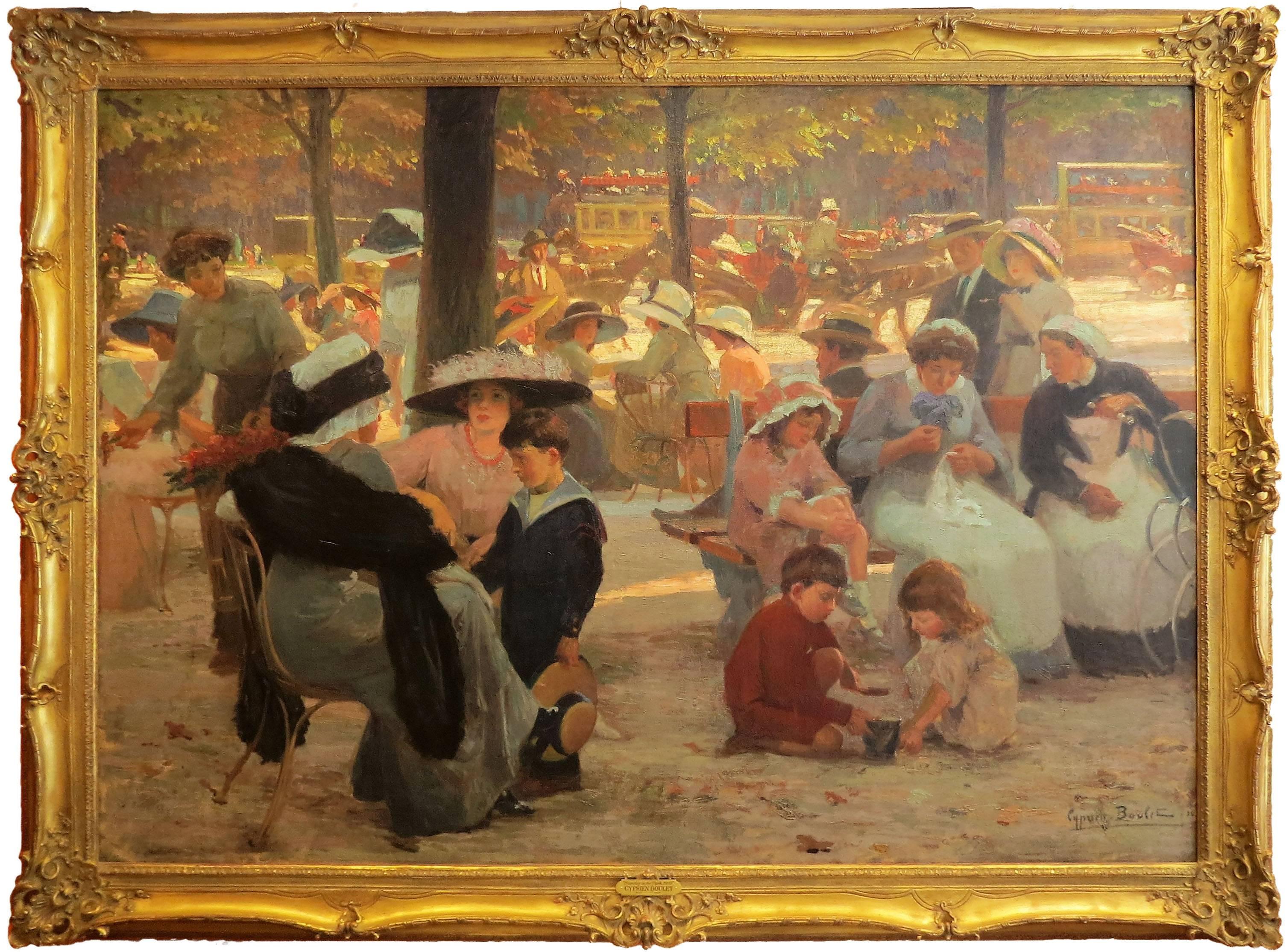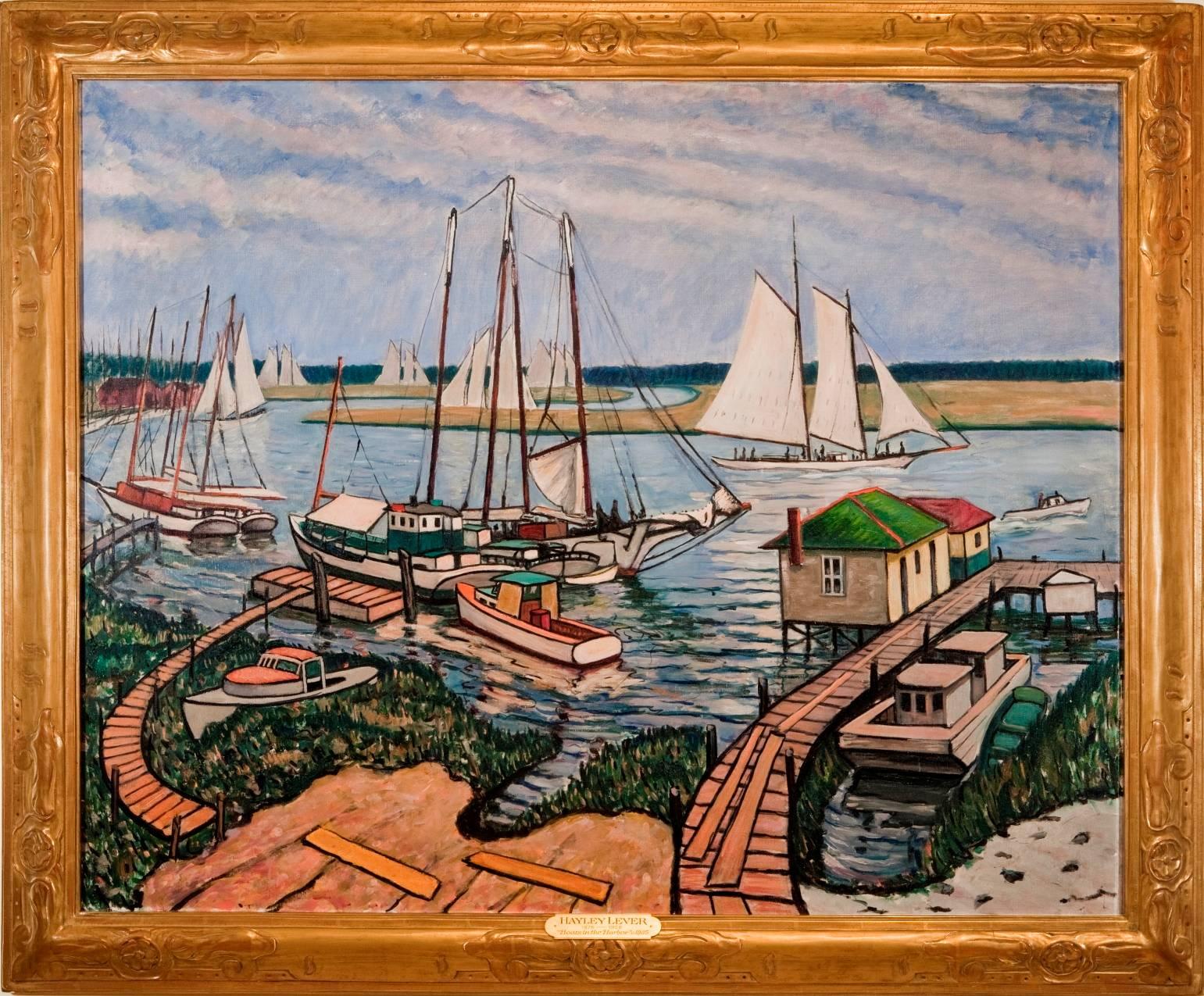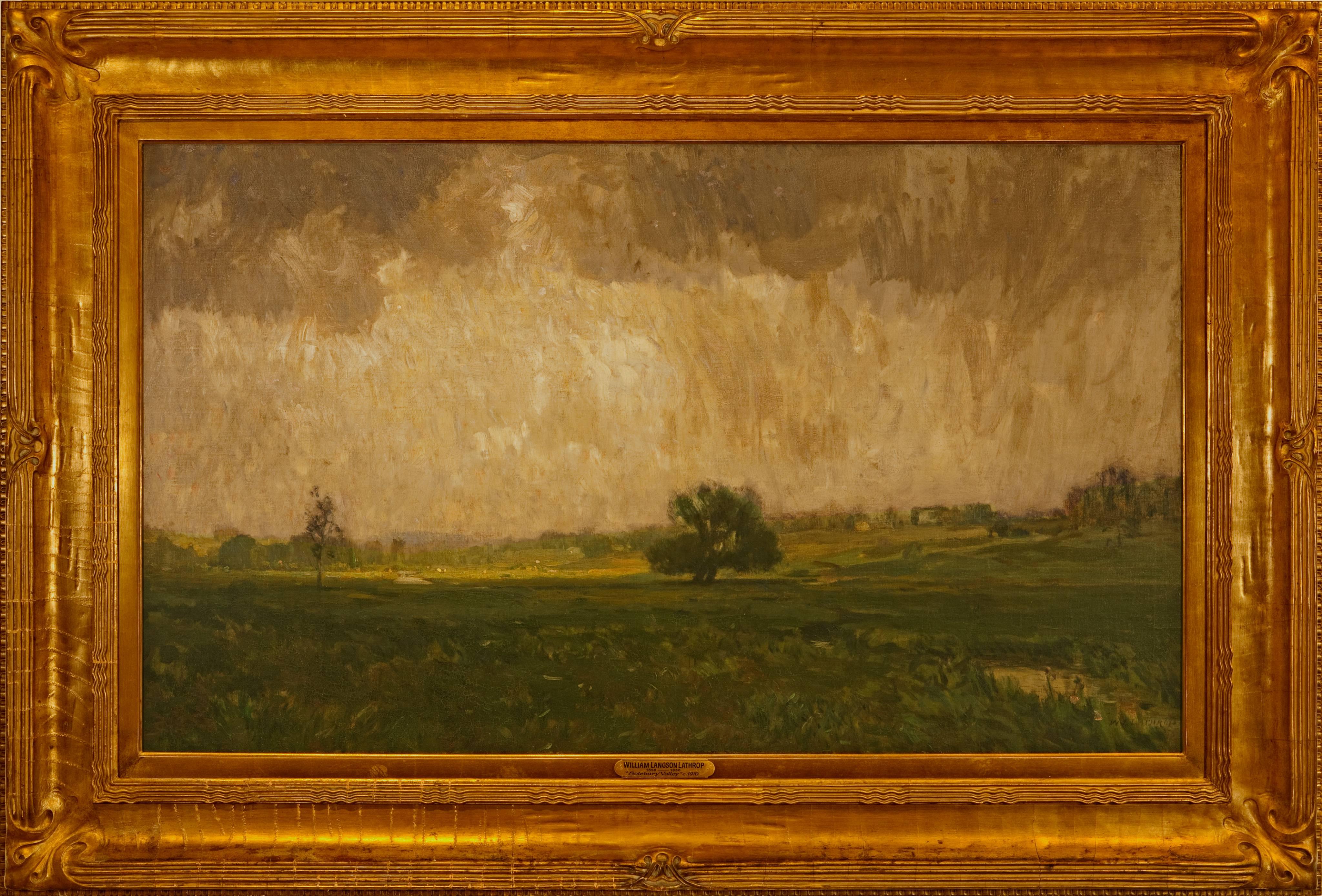Items Similar to "PALA MISSION" Northern San Diego County California Reservation.
Want more images or videos?
Request additional images or videos from the seller
1 of 8
Paul Grimm"PALA MISSION" Northern San Diego County California Reservation.1953
1953
About the Item
Paul Grimm
(1891-1974)
California Artist
Image Size: 24 x 30
Frame Size: 31 x 37
Medium: Oil on Canvas
Dated 1953
"Pala Mission"
The San Antonio de Pala Asistencia, or the "Pala Mission", was founded on June 13, 1816, as an asistencia or "sub-mission" to Mission San Luis Rey de Francia, some twenty miles inland upstream from the latter mission on the San Luis Rey River. Pala Mission was part of the Spanish missions, asistencias, and estancias system in Las Californias—Alta California. Today it is located in the Pala Indian Reservation located in northern San Diego County, with the official name of Mission San Antonio de Pala.[2][4] It is the only historic mission facility still serving a Mission Indian tribe.
Pala (a derivation of the native term Pale, meaning water) was essentially a small rancho surrounded by large fields and herds. The Pala site had been noted by Father Juan Mariner and Captain Juan Pablo Grijalva on an exploratory trip in 1795, when they went up the San Diego River, and then through Sycamore Canyon to the Santa Maria Valley (or Pamó Valley) and into what they named El Valle de San José, now known as Warner Springs. Once Mission San Luis Rey began to prosper, it attracted the attention of numerous mountain Native Americans in the area, who were called the Luiseño by the Spanish.
Spanish era
The Franciscan fathers chose this site for the Pala Mission because it was a traditional gathering place and village for the Native American residents. Father Peyrí oversaw the addition of a chapel and housing to the granary complex, which was constructed at the spot in 1810.[4] The chapel's interior wall surfaces featured paintings by native artists, originally measuring 144 by 27 feet. Workers went into the Palomar Mountains and cut down cedar trees to use as roof beams.[5]
Pala is unique among all of the Franciscan missions in that it boasts the only completely freestanding campanile, or "bell tower," in all of Alta California. By 1820, some 1,300 baptisms had been performed at the outpost.[6] Folk tales about the mission include mention of a prickly pear cactus, which became a local symbol of Christian victory, that grew up at the foot of the cross.[7]
Mexican era
After the nation achieved independence from Spain, the Mexican Congress passed An Act for the Secularization of the Missions of California on August 17, 1833 (the act was ratified in 1834).[8] Father Buenaventura Fortuna surrendered Mission San Luis Rey and all its holdings, including Las Flores Estancia and the Pala Asistencia, to government comisianados (commissioners) Pío Pico and Pablo de la Portillà on August 22, 1835; the assessed value of "Rancho de Pala" was $15,363.25.[9]
More than a decade later, fearful of the impending conquest of Alta California by the United States as a result of the Mexican–American War, Pico sold off all of the holdings (including Pala) to Antonio J. Cot and José A. Pico on May 18, 1846, for $2,000 in silver and $437.50 in wheat (the sale was later declared invalid by the U.S. Government).[6] Through the years, priests from San Luis Rey continued to visit Pala and conduct baptisms, marriages, and worship services.
Pala Asistencia, with its original bell tower, circa 1875. The structure is loosely styled after a similar one at the Mission of Nuestra Señora de Guadalupe located in Juárez, Mexico.[10]
Pala Mission around 1903, falling into ruins
Modern era
On Christmas Day 1899, the San Jacinto earthquake shook the Pala Valley, causing the roof over the church sanctuary to collapse.[11] In 1902, a group named the "Landmarks Club of Southern California", under the direction of American journalist, historian, and photographer Charles Fletcher Lummis, purchased Pala Mission. The following year, the Club returned ownership to the Catholic Church and "saved the Chapel and a few rooms from complete ruin with a timely work of partial restoration."[12]
Pala is the only California mission to have ministered without interruption to the Mission Indians for whom it was originally built.[11] It is also the only sub-mission (Asistencia) still intact. The traditional Corpus Christi Fiesta has been celebrated every year since its founding. Though it lacked a resident priest, Pala served as the "mother" mission to chapels in Cahuilla, La Jolla, Pauma, Pichanga, Rincon, Santa Rosa, and Temecula.[13]
On August 9, 1942 MGM motion picture actress Ruth Hussey was wed at Pala Mission. In 1948 the Verona Fathers (Sons of the Sacred Heart) succeeded the Franciscans in the care of the Mission.[14] Six years later, the fathers undertook a complete restoration of the Mission. In May 1991, administration of the Mission reverted to the Roman Catholic Diocese of San Diego; since June 1996 the Barnabite Fathers have held charge over the Mission's affairs.
Since 1996,[15] Pala has hosted the Vivian Banks charter school[16] (Kindergarten - 5th grade).
Mission bells
Pala's replica bell tower.
Bells were vitally important to daily life at any mission. The bells were rung at mealtimes, to call the Mission residents to work, religious services, birth and funeral ceremonies, and to signal the approach of a ship or returning Spaniard, and other occasions. Novices were instructed in the specific rituals for ringing the mission bells. Pala's bells are the same ones used since 1916. American academician, architect, and author Rexford Newcomb published design studies of the original bell tower in his 1916 work The Franciscan Mission Architecture of Alta California.[17] The structure was completely destroyed by torrential rains later that same year; a precise replica was erected immediately thereafter and still stands today. The structure measures some 35 feet above the base (which is 15 feet off the ground) and supports two bells, each hanging from a rawhide tether.
The large bell, set in the lower embrasure, bears inscriptions in Latin and Spanish as follows (translated into English):
Paul Grimm (1891-1974)
Paul A. Grimm was born of German parents in King Williams Town, South Africa on January 11, 1891. When brought to the United States at age seven, he already showed promise as an artist. At 18 he won a scholarship in Rochester, New York for art study at the Düsseldorf Royal Academy.
After many years at that prestigious school, he moved to Hollywood in 1919 and began his art career painting backdrops for the movie studios. Leaving the movie capital, Grimm settled in Palm Springs in 1932 and remained a resident there for the rest of his life.
He maintained a small studio-gallery in downtown Palm Springs at 428 N. Palm Canyon Road where such notables as President Dwight D. Eisenhower often visited and shared confidences. Eisenhower once wrote, "I profited from the experience of seeing how a real artist creates the effects he wants."
Although Grimm painted scenes of the High Sierra (where he often could be found in summers), missions, and Indian portraits, his fame lies as a painter of the southern California desert and its many moods. One reviewer once wrote, "His canvases of Mt San Jacinto, which for their sheer magnificence and power of conception and execution, rank as probably the finest work ever done on the subject."
Grimm died in Palm Springs on December 30, 1974. Exhibited: San Diego Exposition, 1935.
- Creator:Paul Grimm (1891 - 1974, German)
- Creation Year:1953
- Dimensions:Height: 24 in (60.96 cm)Width: 30 in (76.2 cm)Depth: 3 in (7.62 cm)
- More Editions & Sizes:Image Size: 24 x 30 Frame Size: 31 x 37Price: $15,000
- Medium:
- Movement & Style:
- Period:
- Framing:Frame IncludedFraming Options Available
- Condition:Please visit my storefront for more paintings and antique items.
- Gallery Location:San Antonio, TX
- Reference Number:1stDibs: LU769314433592
About the Seller
5.0
Vetted Seller
These experienced sellers undergo a comprehensive evaluation by our team of in-house experts.
Established in 1974
1stDibs seller since 2017
82 sales on 1stDibs
Typical response time: 1 hour
- ShippingRetrieving quote...Ships From: San Antonio, TX
- Return PolicyThis item cannot be returned.
More From This SellerView All
- " Summer Evening Southwest Texas " 1909 Texas Hill CountryBy Julian OnderdonkLocated in San Antonio, TXJulian Onderdonk "Summer Evening S. W. Texas" Texas Hill Country (1882 - 1922) San Antonio Artist Image Size: 9 x 12 Frame Size: 15 x 18 Medium: Oil on panel Dated 1909 "Summer Evening S. W. Texas" "A Texas Painter Worked Under the Radar in New York," By Eve M. Kahn, March 6, 2014, The New York Times Onderdonk, a San Antonio native who died of an intestinal ailment in 1922, at 40, is best known for painting swaths of Texas bluebonnets. Those canvases can bring more than $500,000 each, while his New York scenes usually end up in the five-figure range. Onderdonk’s parents were painters in San Antonio, and in 1901, when he was a teenager, they sent him to New York for training. Through 1909, he lived in various Manhattan apartments and Staten Island houses. He then returned to Texas, but continued to spend months at a time in New York. In 1902 he had married a Manhattan teenage neighbor, Gertrude Shipman. While she focused on raising their daughter, Adrienne, and worrying about their strained finances, “he created more than 600 works of art, often producing a painting or two a day,” Eyewitnesses recorded his prolific pace in New York, but Onderdonk works bearing those dates rarely turn up. The puzzling gap in his productivity is explained in family correspondence that the Bakers uncovered: The artist admits that he was signing pieces with pseudonyms. He mostly used Chas. Turner and Chase Turner and occasionally resorted to Elbert H. Turner and Roberto Vasquez. Julian Onderdonk was the son of the important Texas landscapist, Robert Onderdonk. He was the father's pupil at age 16. Sponsored by a Texas patron, he studied at the Art Students League in New York when he was 19, the pupil of Kenyon Cox, Frank DuMond, and Robert Henri. He also studied with William Merritt Chase on Long Island. In 1902, having lost his Texas patron because he married, he asked $18 for 12 paintings at a Fifth Avenue dealer in New...Category
Early 1900s Impressionist Landscape Paintings
MaterialsOil
- "IN THE LAND OF THE SPANISH OAK " TEXAS HILL COUNTRY DATED 1910By Julian OnderdonkLocated in San Antonio, TXJulian Onderdonk (1882 - 1922) San Antonio Artist Image Size: 20 x 30 Frame Size: 29 x 39 Medium: Oil Dated 1910 "In The Land Of The Spanish Oak" Spectacular larger scene by Julian...Category
1910s Impressionist Landscape Paintings
MaterialsOil
- "Brackenridge Park" San Antonio Texas.By Jose ArpaLocated in San Antonio, TXJose Arpa (1858-1952) San Antonio Artist Image Size: 18 x 24 Frame Size: 21 x 27 Medium: Oil Circa 1920s "Brackenridge Park" San Antonio Texas. Biography Jose Arpa (1858-1952) Born in Carmona, Spain, José Arpa y Perea was known as "The Colorist Painter" of figures and landscapes, especially in Texas where he brought a fresh approach to San Antonio painting in his bright, sunlit local scenes. He was also an etcher, illustrator, and muralist as well as an art teacher, and he started and ended his career in Spain. His subjects include the Grand Canyon of Arizona. Please visit our 1stdibs storefront to view more of our fabulous goodies. He began his art study as the pupil of Eduardo Cano de la Pena at the Academy of Fine Arts in Seville and then spent six years in Rome followed by extensive travel through Africa and Europe. His reputation was solid enough that the Spanish government sent four of his paintings as part of the exhibition to the 1893 World's Columbian Exposition in Chicago. In 1894, as an illustrator, he accompanied a Spanish army expedition to Morocco where the Spanish had been defeated by Rifi tribesmen. In the mid-1890s, he was brought to Mexico City, reportedly by a special Mexican naval vessel, to head the Academy of Fine Arts, but declined the position once he understood the responsibilities. Instead he joined one of his Spanish schoolmates and went to his home in Puebla, Mexico, where his use of bright colors earned him the name of "Sunshine Man." He became close to the children of this man, and in 1903, accompanied them as a guardian to school in San Antonio. After twenty years of traveling in Spain, Mexico, the Southwest, and South America, Arpa settled in 1923 in San Antonio, Texas, where he became Director of the San Antonio Art School and painted bright, sun-filled landscapes. He taught landscape and portrait painting and was exceedingly prolific, and several San Antonio collectors accumulated large numbers of his works. Among his close artist friends were Robert and Julian Onderdonk, Tom and Joe Brown, and Charles Simmang. They were members of a San Antonio group who painted together and called themselves the "Brass Mug...Category
1920s Impressionist Landscape Paintings
MaterialsOil
- "STAGING ON THE SOUTHERN ARIZONA TRAIL" STAGECOACH ARIZONA / CALIFORNIABy Marjorie ReedLocated in San Antonio, TXMarjorie Reed a.k.a. Harvey Day (1915-1996) California, Arizona Artist Image Size: 16 X 20 Frame Size: 22 X 26 Medium: Oil on Canvas "Valley of the Monuments"Category
20th Century Impressionist Landscape Paintings
MaterialsOil
- "BLUEBONNETS IN BLOOM" TEXAS HILL COUNTRY FRAMED 22 X 26 BORN 1949 HEAVY IMPASTOBy Robert HarrisonLocated in San Antonio, TXRobert Harrison (Born 1949) San Antonio Artist Image Size: 16 x 20 Frame Size: 21.5 x 25.5 Medium: Oil on Canvas "Bluebonnets in Bloom" Biography Robert Harrison (Born 1949) Robert H...Category
Early 2000s Impressionist Landscape Paintings
MaterialsOil
- "A TEXAS TRAIL" TEXAS HILL COUNTRY FRAME 30 x 36 BLOOMING PRICKLY PEAR BORN 1949By Robert HarrisonLocated in San Antonio, TXRobert Harrison (Born 1949) San Antonio Artist Image Size: 24 x 30 Frame Size: 30 x 36 Medium: Oil on Canvas Dated 2010 "A Texas Trail" Hill Country Blooming Prickly Pear Cactus Biog...Category
20th Century Impressionist Landscape Paintings
MaterialsOil
You May Also Like
- 'Agay, le château et le Sémaphore'. Oil on canvas. Signed.By Armand GuillauminLocated in Paris, FR'Agay, le château et le Sémaphore'. Oil on canvas. +/- 1922 Signed lower right Measurements : 60 x 73 cm. This painting will be recorded in the second volume of the Catalogue Raisonn...Category
1920s Impressionist Landscape Paintings
MaterialsOil
- "Sunday in the Park, 1910"By Cyprien Eugène BouletLocated in Lambertville, NJSigned Lower Right Cyprien-Eugène Boulet (1877 - 1927)Category
Early 20th Century Impressionist Landscape Paintings
MaterialsCanvas, Oil
- "Boats in the Harbor"By Hayley LeverLocated in Lambertville, NJOriginal Period Frame Hayley Lever (1876 - 1958) Hayley Lever's exceptional career path took him from the shores of his native Australia to those of England, and then the United S...Category
1930s Impressionist Landscape Paintings
MaterialsCanvas, Oil
- "Alley Fiends"By John R. GrabachLocated in Lambertville, NJJim’s of Lambertville is proud to offer this artwork by: John R. Grabach (1886 - 1981) John Grabach was a highly regarded New Jersey artist, teacher, and author of the classic text...Category
1930s American Impressionist Landscape Paintings
MaterialsCanvas, Oil
- "Forest Strongholds"By John F. CarlsonLocated in Lambertville, NJSigned lower right. Complemented by a hand carved and gilt frame. Exhibited at the National Academy of Design, 1928Category
20th Century American Impressionist Landscape Paintings
MaterialsCanvas, Oil
- "Solebury Valley"By William Langson LathropLocated in Lambertville, NJSigned lower right. Complemented by a period frame. William L. Lathrop (1859-1938) Deemed “Father of the New Hope Art Colony”, William Langson Lathrop was born in Warren, Illinois. He was largely self-taught, having only studied briefly with William Merritt Chase in 1887, at the Art Students League. Lathrop first moved east in the early 1880s, and took a job at the Photoengraving Company in New York City. While there, he befriended a fellow employee, Henry B. Snell. The two men became lifelong friends and ultimately, both would be considered central figures among the New Hope Art Colony. Lathrop's early years as an artist were ones of continuing struggle. His efforts to break through in the New York art scene seemed futile, so he scraped enough money together to travel to Europe with Henry Snell in1888. There he met and married an English girl, Annie Burt. Upon returning to New York, he tried his hand at etching, making tools from old saw blades...Category
1910s American Impressionist Landscape Paintings
MaterialsCanvas, Oil




